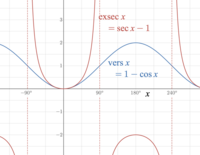Exsecant and excosecant

Exsecant and excosecant are like cousins of two other math terms called secant and cosecant. Just like how you have cousins that are similar to you but not exactly the same, exsecant and excosecant are similar to secant and cosecant but with some differences.
Let's start by explaining what secant and cosecant are. Secant is a line that touches a circle at two points, while cosecant is the length of a line segment that extends from the center of the circle to the edge of the circle.
Exsecant and excosecant are a little bit different. Exsecant is a line that touches a circle at one point and then extends beyond the edge of the circle. Excosecant is the length of a line segment that starts at the center of the circle and extends beyond the edge of the circle.
Think of it like this: imagine you have a big ball (the circle) and a stick (the line). If you put the stick on the ball so that it just touches the ball at one point and then stick it straight up in the air, that's an exsecant. If you put the stick on the ball so that it starts at the center and goes all the way to the edge, that's an excosecant.
Exsecants and excosecants are useful in math because they can help us solve problems in geometry and trigonometry. For example, we can use them to find the distance between two points on a circle or the angle between two lines that intersect at the edge of a circle.
So, to sum it up: exsecants and excosecants are like cousins of secants and cosecants, but with some differences. They are important in math because they help us solve problems related to circles and angles.
Let's start by explaining what secant and cosecant are. Secant is a line that touches a circle at two points, while cosecant is the length of a line segment that extends from the center of the circle to the edge of the circle.
Exsecant and excosecant are a little bit different. Exsecant is a line that touches a circle at one point and then extends beyond the edge of the circle. Excosecant is the length of a line segment that starts at the center of the circle and extends beyond the edge of the circle.
Think of it like this: imagine you have a big ball (the circle) and a stick (the line). If you put the stick on the ball so that it just touches the ball at one point and then stick it straight up in the air, that's an exsecant. If you put the stick on the ball so that it starts at the center and goes all the way to the edge, that's an excosecant.
Exsecants and excosecants are useful in math because they can help us solve problems in geometry and trigonometry. For example, we can use them to find the distance between two points on a circle or the angle between two lines that intersect at the edge of a circle.
So, to sum it up: exsecants and excosecants are like cousins of secants and cosecants, but with some differences. They are important in math because they help us solve problems related to circles and angles.
Related topics others have asked about:
